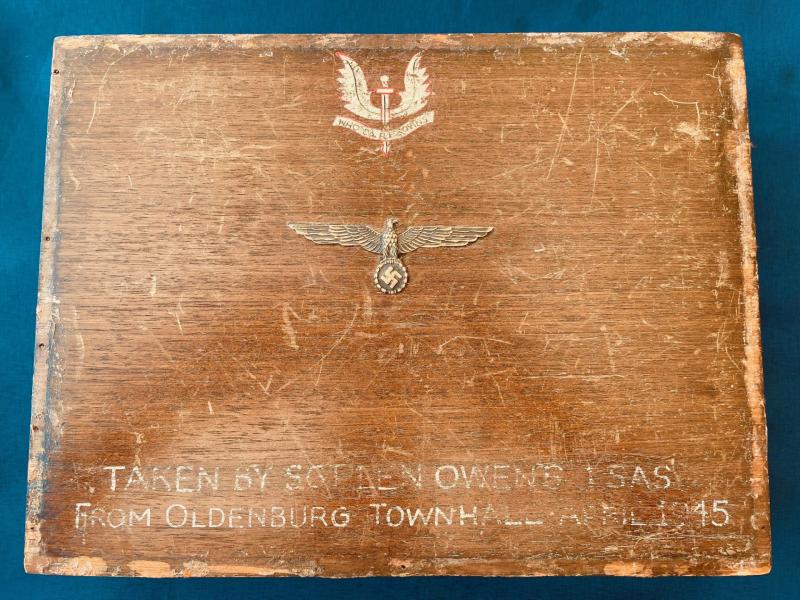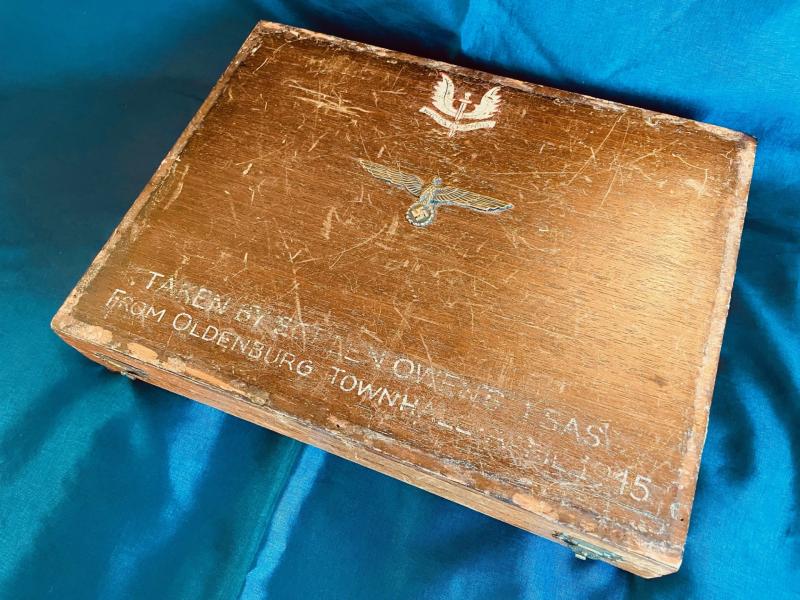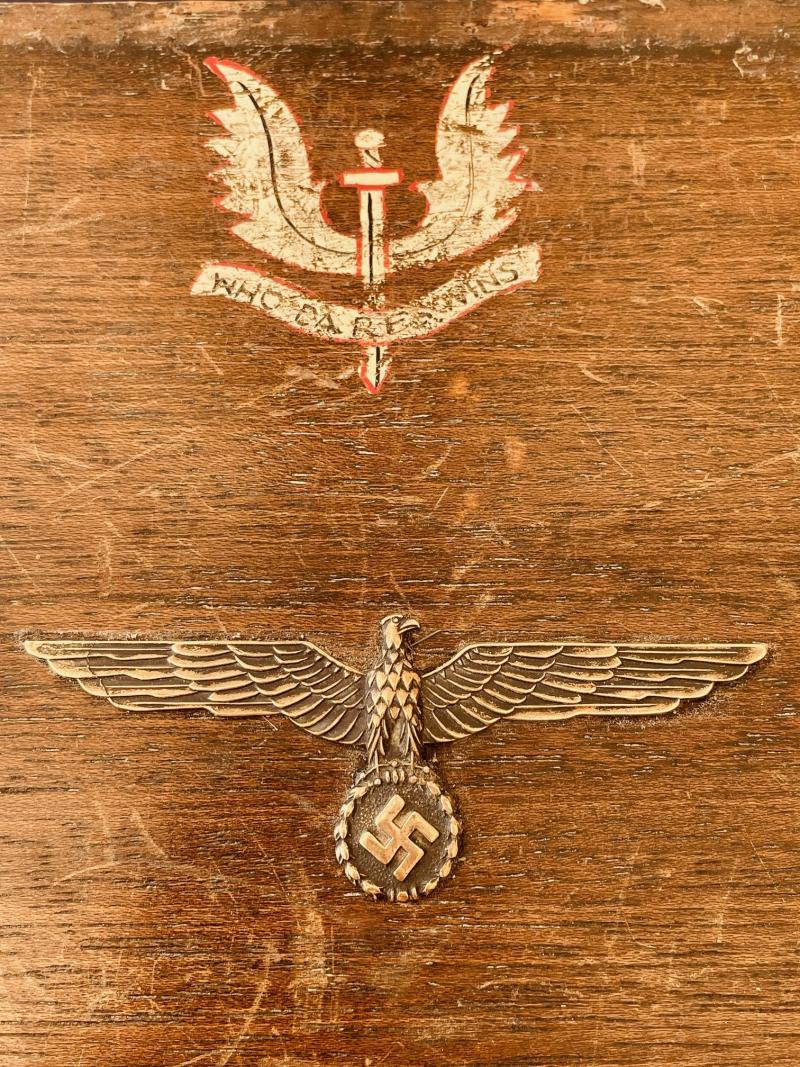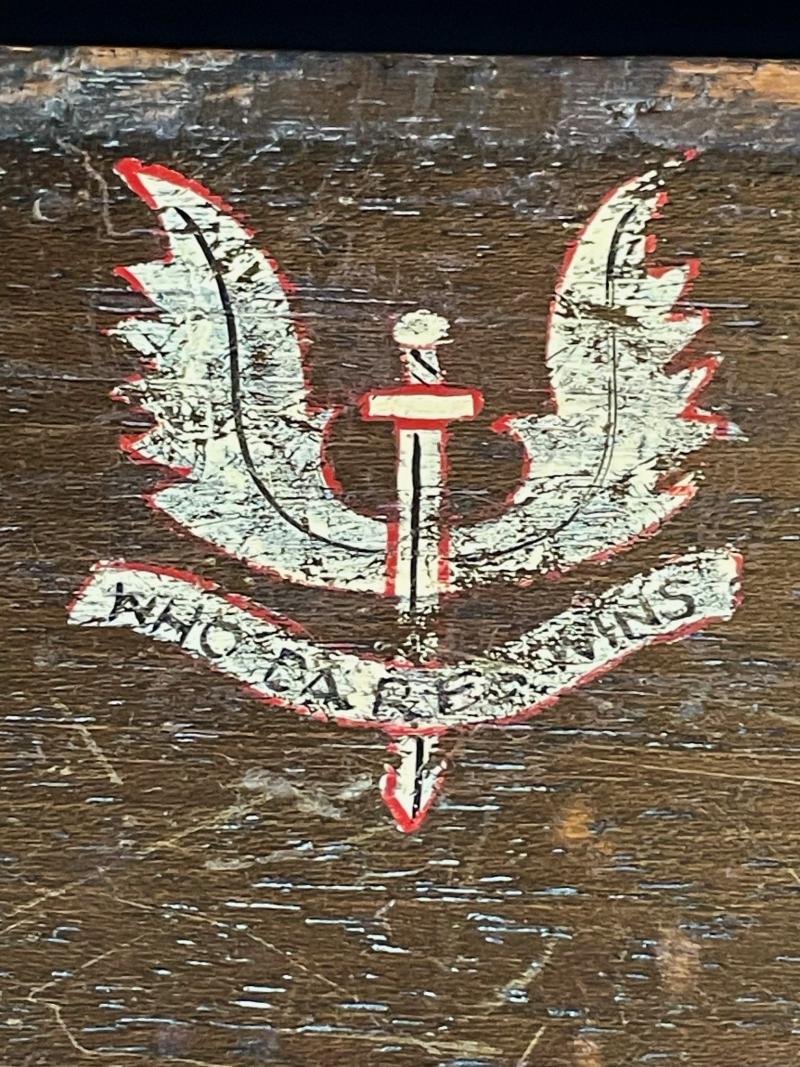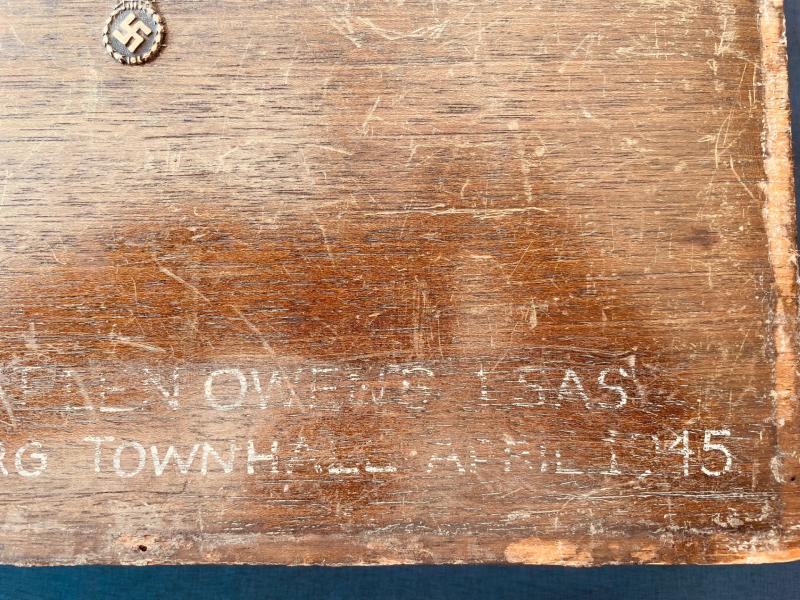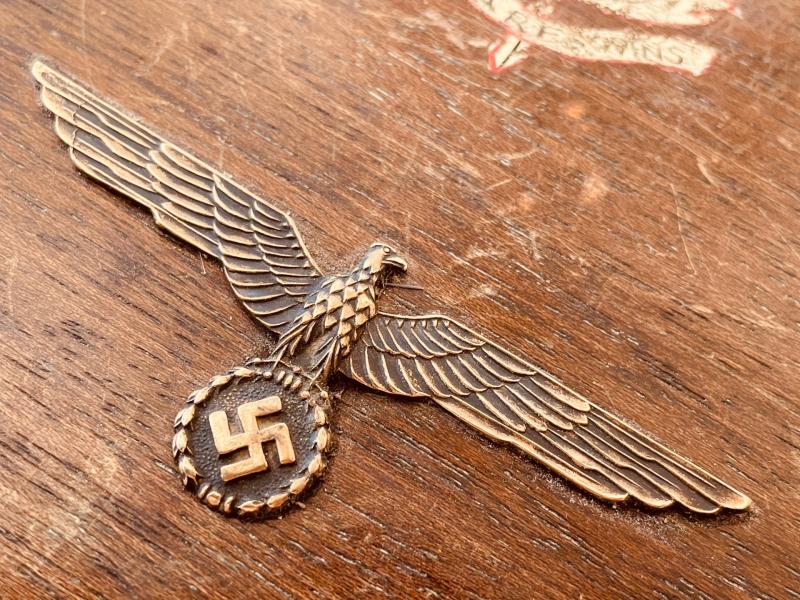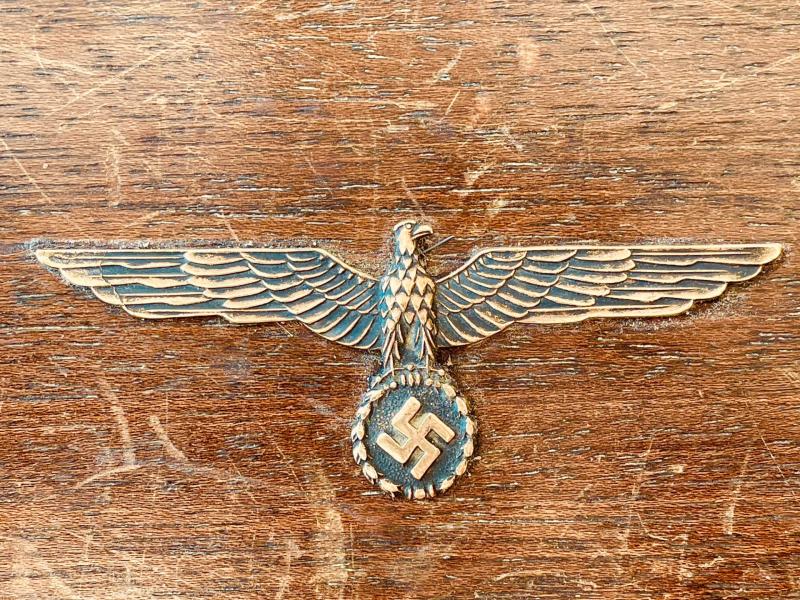VERY RARE WWII 1st SAS (SPECIAL AIR SERVICE) REGIMENT COLLECTION, SGT LEN OWEN.
Wonderful opportunity to obtain an incredibly Rare 1st SAS wooden case and collection with items taken by Sargent Len Owen during WWII, whilst serving with the elite 1ST SAS Regiment and undertaking crucial special operations, that would eventually save many lives. This ultra rare case was made to house some of Sergent Len Owens private items, which were collected by him during his service with the Famous elite 1st SAS regiment. The case is made from wood with double hinge back attachments in perfect working order with double scrolled catches to the front, the outside of the case we see the famous SAS motto badge insignia with its well-known motto Who Dares Wins logo, paint inscribed onto the surface, below this a most beautiful German army eagle swastika, metal plaque emblem with fine detailing to its entirety, which is securely fitted onto the box. Below this, again paint finished, applied wording, which reads - Taken by Sgt Len Owen 1 SAS from Oldenburg Townhall April 1945. This rare case contains a collection of items, which include a heavy metal wall plaque of the side bust depicting Adolf Hitler with two holes fixing holes, a metal Luftwaffe plaque Techniker Mützenabzeichen, the obverse consisting of a cogwheel overlaid with a Luftwaffe eagle clutching a swastika, the reverse has all three attachment prongs intact, both items unmarked and still showing good detailing. A Nazi Third Reich armband of the NSDAP which is a multi-construction cotton cloth band in very good condition, lastly a NSDAP membership Party lapel badge with RZM and maker code number marked to reverse M1/42 for the manufacturer Kerbach & Israel of Dresden in great condition. To inside of the wooden lid, a cut out of an early German magazine page of Luftwaffe high ranking officers all wearing the Third Reich knights cross of the iron cross. all wording is in German; the cases contents are authentic totally original WWII Third Reich period items. 4 in total. The case shows much usage with surface scratching to its entirety. The elite 1st SAS Regiment coursed such chaos during their special covert operations against the nazis that Adolf Hitler himself personally ordered any SAS personnel that were captured to be executed immediately, anyone that disobeyed that order would face a firing squad themselves. A fantastic opportunity to obtain items collected from soldier Len Owen that severed with the Uks finest elite 1st SAS regiment. This particular box set of 1st SAS related items came from a very large collection of other SAS period cap badges, buttons, and cloth insignia items, all of which were collected by a gentleman beginning in his childhood and continued throughout his lifetime, The collector is now sadly deceased and some of his collection is now available for sale. The photos of Len Owen, Paddy Maynes and the SAS in action do not come with this sale and are for reference purposes only.
Size of case: 320mm x 245mm x 60mm
Len Owen:
Sargent Len Owen was Paddy Maynes Signaller during the latter part of WWII while serving with the elite 1st SAS Regiment, he was a skilled radio operator with the "Phantom" GHQ Liaison Regiment, a crucial component of the SAS's wartime operations. He played a vital role in communication and was awarded the Military Medal for his service, particularly during Operation Howard.
Paddy Mayne:
Robert Blair "Paddy" Mayne was the most highly decorated and admired SAS officer of the regiment’s history, known for his courage and leadership. He served in various roles, including as a commanding officer and a key figure in the SAS's operations in occupied France and other theatres of war.
Their Connection:
Mayne and Owen served together in the SAS and their relationship highlights the importance of communication and collaboration within the special force’s unit. Mayne's respect for Owen as a "real hero" underscores the value of the radio operator's role in the SAS's success. Len Owens was a SAS radio operator who was once described by his CO in World War II, Ulsterman Blair 'Paddy' Mayne, as a real hero. Lt-Col Mayne, from Newtownards, who was awarded the DSO plus three bars for his courage in action, had great respect for Liverpool man Owens, who served under him in the SAS.
SAS SPECIAL AIR SERVICE
Special Air Service carry out complex military tasks in difficult conditions all over the world, often with little direct support from other units. The special Air Service are tasked to the highest level and can operate in difficult and often changing terrain and circumstances. The selection process for the SAS is one of the most difficult and toughest training programs in the world. Its purpose is to test candidates to the utmost limit of their physical and mental abilities through rare, it is not unheard of for candidates to actually die during the selection process due to extreme human endurance.
THE SPECIAL AIR SERVICE SAS MOTTO INSIGNIA
The shield: Represents the unit's history and origins, particularly its association with the British Army. The white sword: Symbolizes the SAS's combat capabilities and its direct-action roles. The wings: Represent the SAS's airborne operations and its ability to deploy swiftly and effectively behind enemy lines. The motto "Who Dares Wins": This famous phrase encapsulates the SAS's spirit of daring and its willingness to undertake highly risky missions. It was chosen by David Stirling to reflect the unit's unconventional and daring approach to warfare.
Sgt Len Owen
Len served as a Sergeant in the Royal Signals. Len had hoped to join the Navy and responded to appeals for volunteers for 'Hazardous duties' including' 'amphibious landings. He was sent off to Achnacarry in Scotland to train as part of Combined Operations Command. While in Achnacarry his ability with radio communication was recognised and he volunteered for the Phantom Signals (GHQ Liaison Regiment). Len's first operation was with the landings in Sicily and he remembers toiling up the beach with a massive radio on a trolley. In 1944 he was operating with 'F Squadron Phantom. 'Phantom' was to operate in France in 1944 and carried out a special role to provide communications for the SAS in 'Operation Layton. Len, with 'Phantom' and the SAS were parachuted behind enemy lines into the Vosges Mountains around Moussey, to organise and arm the local resistance. Their job was to disrupt the enemy in advance of General Patton's Third Army drive through the Vosges Mountains to Strasbourg. In this operation 3 men with Phantom' was killed:
Further details
Phantom patrols were particularly active after D-Day, when their major role involved racing around Normandy to locate and report the position of all the various Allied units. Early in August 1944, however, Owens found himself behind enemy lines supporting a small party of 2 SAS Regiment near Messac, south of Rennes in Brittany. Their mission, code-named DUNHILL, was to liaise with the French Resistance and monitor enemy troop movements heading from the south to bolster defences at the Normandy Bridgehead. Quickly overtaken by General Patton's Third Army, they decided to move northeast to Le Mans to join forces with another SAS unit. Having no transport, they commandeered a number of civilian cars, ripping off their doors to ensure an unobstructed field of fire. On learning that a large number of British PoWs were hiding in a forest, they requisitioned buses, adding to the mission's unconventional vehicle fleet, to ferry those on the run to safety.
Len Owen took part in Operation HOWARD with the 1 SAS under the command of Lt-Col Paddy Mayne. He was in charge of the wireless communications of a squadron of armoured jeeps operating as forward reconnaissance in Holland and German support of the Second Canadian Army. Demobilised in 1946, Owens was awarded a Military Medal. He returned to his former job in Liverpool, but was unhappy with the pay. He then worked for Rediffusion in Newcastle before running a news agency from 1950 to 1967. For the last part of his working life he was district controller of Social Services for Teasdale. He retired in 1985.
He married Tess Swart in 1946; she predeceased him, and he was survived by their son and daughter. Operation Howard was a British special forces operation by B and C Squadrons, 1st Special Air Service led by Paddy Mayne that took place from 6 to 29 April 1945. It was to provide reconnaissance for the Canadian 4th Armoured Division in its advance towards Oldenburg in north-western Germany. The operation was hampered by German ambushes and boggy ground in which the Jeeps found hard going. The operation succeeded in its objective but suffered a number of casualties. The 1st and 2nd Special Air Service had achieved considerable success with them behind the lines raiding during and after Operation Overlord - notably Operation Bulbasket, Operation Houldsworth, Operation Layton and Operation Wallace. Following these operations both of the Special Air Service regiments were recalled to the United Kingdom. They were to regroup and refit, for the final push into Germany the following year. As they would no longer be behind German lines, their role had changed as they would accompany the leading reconnaissance forces, in fast moving jeep columns. They were to probe and breakthrough the forward German Units to enable a rapid advance for the main party of the Army. On the night of 23 March Operation Plunder saw the British 21st Army Group penetrate into Germany by crossing the Rhine. Three days later the SAS also crossed the river with Operation Archway supporting the airborne Howard The forty Jeeps with 180 men in total travelled in two columns, and entered German held territory. The terrain was far from ideal as it was crisscrossed by dykes and waterways. Nevertheless, the SAS troopers advanced 37 miles (60 km) in three days, sometimes going too far ahead of the supporting Canadian armour. The SAS troopers soon discovered that their Jeeps had to deal with German ambush parties, armed with Panzerfausts. Their opponents were elements of Wolfgang Erdmann's 7th Parachute Division which were in positions facing the 4th Canadian armoured division. Mayne's rescue of B Squadron Squadron led by Major Dick Bond was caught in an ambush in woodland as it approached the village of Börger. Bond was killed along with his driver Trooper Lewis - several of his men were pinned under heavy fire outside the village from a series of farm buildings. The leading patrols were thus held up, but after hearing the reports on the radio, Mayne arrived and took over a jeep, while another officer Lieutenant John Scott volunteered as rear gunner. 8 Another trooper Billy Hull managed to find a way into one of the farm buildings opening up distracting fire which revealed the ambushers positions. Mayne meanwhile drove flat out down the road, with Scott firing the Browning and Vickers machine gun from the jeep suppressing the attackers. Mayne turned around and repeated the attack on the way back, turning again to collect the wounded from the dyke and brought them to safety. German fire began to wane so Mayne and Hull then went from house to house clearing away any opposition. By this time the Germans had withdrawn leaving the wood and farm buildings in SAS hands.
The Canadian armour which was supposed to be following on the squadrons had not caught up. Mayne decided to withdraw back to Canadian lines so that the casualties could get urgent medical attention. Three miles from the battle Mayne buried Bond and Lewis at the side of a farmhouse.
Further actions. The following day, 11 April, Mayne's force pushed on and battled past near the village of Esterwegen. They then had to move into flooded woodland which proved too difficult to work in. In addition, the roads were heavily mined so the Jeeps had to go through fields which were also waterlogged. 9 In the afternoon C squadron were heading towards the town of Friesoythe. It was heavily defended and the outskirts aggressively patrolled - several hundred paratroopers from Battalion Raabe and anti-tank guns defended the town. On the outskirts the SAS were ambushed by mortar bombs - two Jeeps were destroyed, while an eight-man patrol that had decided to go forward on foot were captured after being surrounded. The SAS meanwhile managed to wait for the 4th Canadian armoured to come up and relieve them and the Germans retreated. The Canadians then battled for Friesoythe capturing it two days later - the town was controversially razed. Mayne had voiced concerns to Calvert that the
SAS might be misused by SHAEF, and that his unit was not being used to the best advantage. On 12 April Mayne decided to merge the two squadrons into one under the command of Tony Marsh. It soon became apparent that the SAS had to change tactics. Hiding in the woods an old SAS favourite turned out to be a disadvantage. On 29 April the SAS moved to the area in the area of Westerscheps, just West of Oldenburg. A radio message tip off that a motorised German troop convoy was approaching near to C Squadron's position near Oldenburg. The SAS set up an ambush and on observation it was more of a convoy consisting of horse drawn carts. The Vickers and Browning machine guns caused huge destruction. When the SAS returned to the site the next day the damage they had inflicted was immense - the area was covered in German corpses as well as several burnt-out halftracks. Between 3 and 4 May the city of Oldenburg was captured by the Canadians supported by the SAS. Mayne's two units went north of the city - a trooper was killed by a mine and in that time the SAS were being extra vigilant given the inevitable German surrender which took place on 5 May.
Condition: all in used condition please view photos
Code: 51063
2650.00 GBP



